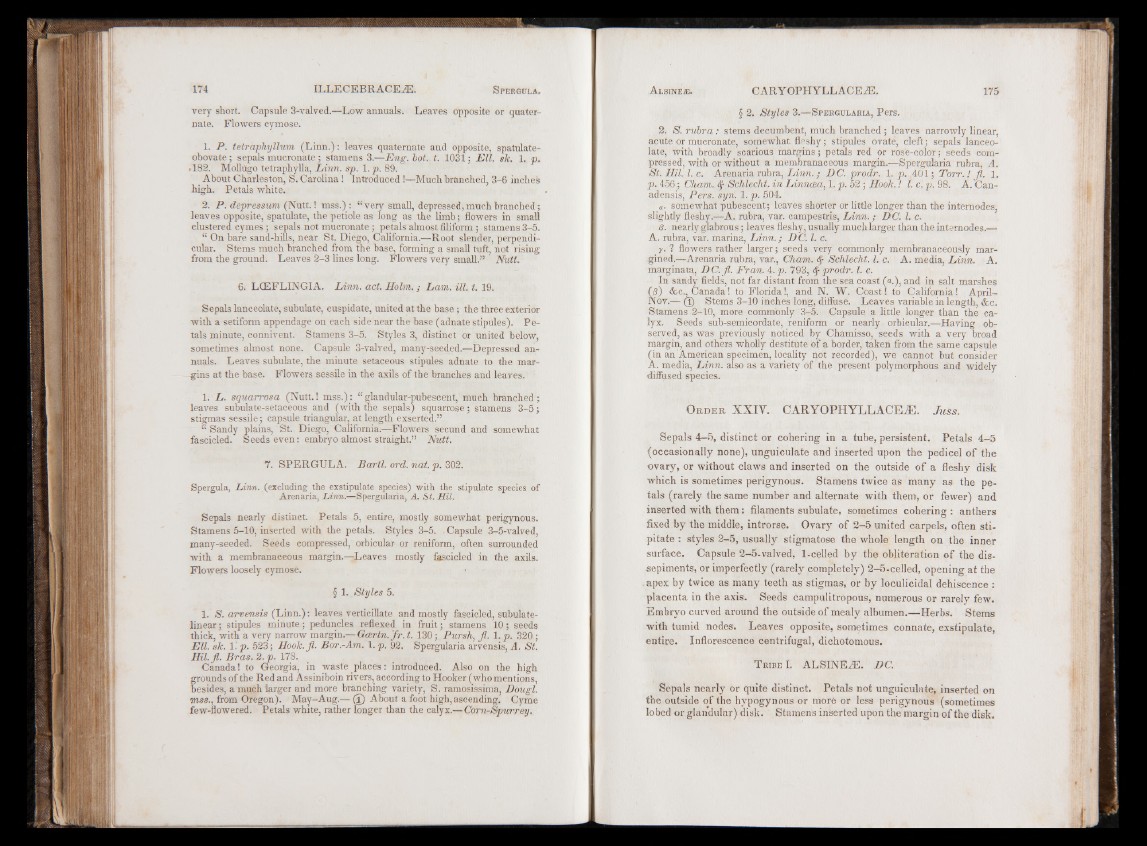
very short. Capsule 3-valved.—Low annuals. Leaves opposite or quater-
nate. Flowers cymose.
1. P. tetraphyllum (Linn.): leaves quaternate and opposite, spatulate-
obovate; sepals mucronate; stamens 3.—Eng. hot. t. 1031; Ell. sk. 1. p.
.182. Mollugo tetraphylla, Linn. sp. 1. p. 89.
About Charleston, S. Carolina ! Introduced !—Much branched, 3-6 inches
high. Petals white.
2. P. depressum (Nutt.! mss.): “ very small, depressed, much branched;
leaves opposite, spatulate, the petiole as long as the limb; flowers in small
clustered cymes; sepals not mucronate ; petals almost filiform ; stamens 3- 5.
“ On bare sand-hills, near St. Diego, California.—Root slender, perpendicular.
Stems much branched from the base, forming a small tuft, not rising
from the ground. Leaves 2-3 lines long. Flowers very small.” Nutt.
6. LCEFLINGIA. Linn. act. Holm.; Lam. ill. t. 19.
Sepals lanceolate, subulate, cuspidate, united at the base; the three exterior
with a setiform appendage on each side near the base (adnate stipules). Petals
minute, connivent. Stamens 3-5. Styles 3, distinct or united below,
sometimes almost none. Capsule 3-valved, many-seeded.—Depressed annuals.
Leaves subulate, the minute setaceous stipules, adnate to the margins
at the base. Flowers sessile in the axils of the branches and leaves.
1. L. squamosa (Nutt.! mss.): “ glandular-pubescent, much branched;
leaves subulate-setaceous and (with the sepals) squarrose; stamens 3- 5 ;
stigmas sessile; capsule triangular, at length exserted.”
“ Sandy plains, St. Diego, California.—Flowers secund and somewhat
fascicled. Seeds even: embryo almost straight.” Nutt.
7. SPERGULA. Bartl. ord. not. p. 302.
Spergula, Linn, (excluding the exstipulate species) with the stipulate species of
Arenaria, Linn.—Spergularia, A. St. HU.
Sepals nearly distinct. Petals 5, entire, mostly somewhat perigynous.
Stamens 5-10, inserted with the petals. Styles 3-5. • Capsule 3-5-valved,
many-seeded. Seeds compressed, orbicular or reniform, often surrounded
with a membranaceous margin.—Leaves mostly fascicled in the axils.
Flowers loosely cymose.
§ 1. Styles 5.
1. S. arvensis (Linn.): leaves verticillate and mostly fascicled, subulate-
linear ; stipules minute; peduncles reflexed in fruit; stamens 1 0 ; seeds
thick, with a very narrow margin.—Gcertn.fr. t. 130 ; Pursh, fl. 1. p. 320 ;
Ell. sk. 1 ’. p. 523 ; Hook. fl. Bor.-Am. 1. p. 92. Spergularia arvensis, A. St.
Hil. fi. Bras. 2. p. 178.
Canada! to Georgia, in waste places: introduced. Also on the high
grounds of the Red and Assiniboin rivers, according to Hooker (who mentions,
besides, a much larger and more branching variety, S. ramosissima, Dougl.
mss., from Oregon). May-Aug.— © About a foot high, ascending. Cyme
few-flowered. Petals white, rather longer than the calyx.— Corn-Spurrey.
§ 2. Styles 3.-—S pergularia, Pers.
2. S. rubra: stems decumbent, much branched; leaves narrowly linear,
acute or mucronate, somewhat .fleshy; stipules ovate, cleft; sepals lanceolate,
with broadly scarious margins; petals red or rose-color; seeds compressed,
with or without a membranaceous margin.—Spergularia rubra, A.
St. HU. 1. c. Arenaria rubra, L in n . £ DC. prodr. 1. p. ,401; Tom. ! fl. 1.
p. 456; Cham. Schlecht. in Linncea, 1. p. 52 ; Hook.! 1. c. p. 98. A. Canadensis,
Pers. syri. 1. p. 504.
a. somewhat pubescent; leaves shorter or little longer than the internodes,
slightly fleshy.—A. rubra, var. campestris, L in n .; DC. 1. c.
8. nearly glabrous; leaves fleshy, usually much larger than the internodes.—
A. rubra, var. marina, L in n .; DC. 1. c.
y. I flowers rather larger; seeds very commonly membranaceously margined.—
Arenaria rubra, var., Cham. <$■ Schlecht. 1. c. A. media, Linn. A.
marginata, DC. fl. Fran. 4. p. 793, fy prodr. 1. c.
In sandy fields, not far distant from the sea coast (“.), and in salt marshes
{/?) &c., Canada! to Florida!, and N. W. Coast! to California! April-
Nov.— (T) Stems 3-10 inches long, diffuse. Leaves variable in length, &c.
Stamens 2-10, more commonly 3-5. Capsule a little longer than the calyx.
Seeds sub-semicordate, reniform or nearly orbicular.—Having observed,
as was previously noticed by Chamisso, seeds with a very broad
margin, and others wholly destitute of a border, taken from the same capsule
(in an American specimen, locality not recorded), we cannot but consider
A. media, Linn, also as a variety of the present polymorphous and widely
diffused species.
O r d e r XXIV. CARYOPHYLLACEiE. Juss.
Sepals 4 -5 , distinct or cohering in a tube, persistent. Petals 4 -5
(occasionally none), unguiculate and inserted upon the pedicel o f the
ovary, or without claws and inserted on the outside o f a fleshy disk
which is sometimes perigynous. Stamens twice as many as the petals
(rarely the same number and alternate with them, or fewer) and
inserted with them: filaments subulate, sometimes cohering : anthers
fixed by the middle, introrse. Ovary o f 2 -5 united carpels, often sti-
p ita te: styles 2-5, usually stigmatose the whole length on the inner
surface. Capsule 2-5-valved, 1-celled by the obliteration o f the dissepiments,
or imperfectly (rarely completely) 2-5-celled, opening at the
apex by twice as many teeth as stigmas, or by loculicidal dehiscence :
placenta in the axis. Seeds campulitropous, numerous or rarely few.
Embryo curved around the outside of mealy albumen.— Herbs. Stems
with tumid nodes. Leaves opposite, sometimes connate, exstipulate,
entire. Inflorescence centrifugal, dichotomous.
T ribe I. ALSINE^E. DC.
Sepals nearly or quite distinct. Petals not unguiculate, inserted on
the outside o f the hypogynous or more or less perigynous (sometimes
lobed or glandular) disk. Stamens inserted upon the margin o f the disk.